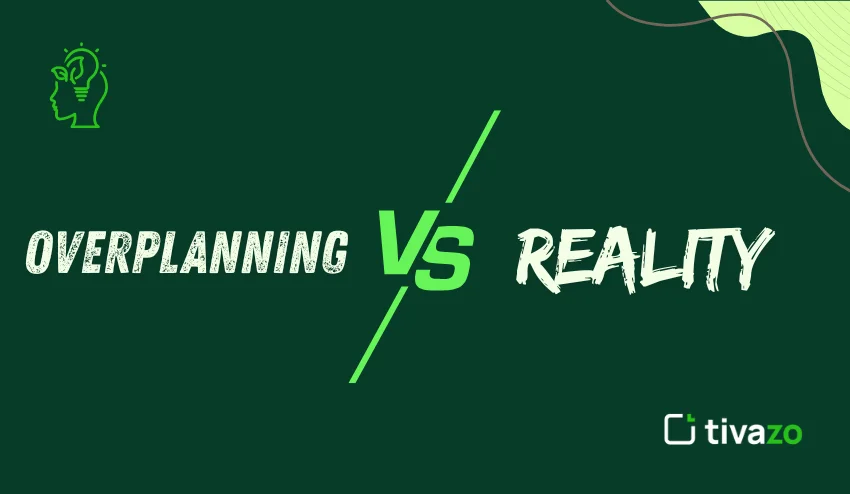Have you ever been stuck in a never-ending planning cycle that experience doesn’t resolve? That’s the dilemma of overplanning vs reality: when you plan carefully for too long, you waste time and miss the opportunity to execute. We all want certainty and agency, but reality hardly ever follows the rules we write down. Your projects can come to a standstill, you miss deadlines, and your team loses momentum.
In this blog, we are going to highlight why overplanning vs reality is more significant than you realize and how to achieve the right amount of balance. You will learn the signs that you have overplanned, some practical ways to keep the execution moving, and some ideas to be nimble when life does not follow the plan. At the end of the blog, you will understand why “just enough planning” is actually what drives productivity, accountability, and sustainable success.
Overplanning and Reality: Striking the Balance for Successful Outcomes
Planning is extremely important. It creates structure, direction, and promotes clarity. But plan for the sake of planning, and the distance between planning and reality grows. Many teams and professionals will get stuck generating never-ending strategies, frameworks, and plans, and experience inertia in progressing. The consequence? Missed deadlines, analysis paralysis, wasted energy.
This reading will unpack overplanning vs reality, determine what to plan is over the top, and illustrate useful strategies to achieve the balance of structured intervention and flexibility.
The truth is, no matter how thoughtful or careful we prepare, the world unfolds differently. The market changes, the customer changes its demands, and our team’s dynamics have shifted. In moments of dispersion, the obsessives about perfect planning have found themselves behind. Those who acted (and adapted – learn faster) found themselves positioned to be successful (and earn the right to do again). This process of overplanning versus reality is not only theoretical – it is grounded in practice that every leader, manager, or organization works through daily.
Understanding when planning has stopped and execution has begun can be the difference between a successful team and stagnation. Through case studies, practical tools, and mindset approaches, this reading will help identify the pitfalls of overplanning and give you additional tools to help you conjoin your plans with reality.
What is Overplanning vs Reality?
Overplanning vs reality is the gap between endless planning/ preparations and actual plans being enacted. The theory of planning is to limit risk; however, we often find that too much planning leads to inaction.
- Overplanning: A hyper-focus on securing every detail.
- Reality: Constant change in unpredictable ways makes any preplanned action inflexible/respond.
The real struggle is in aligning these two areas
If you examine overplanning versus reality closely, you will see that the concern usually is a fear of the unknown. Many individuals and teams become so wrapped up in perfecting a plan, they never actually begin to act on it. The thought is that every variable has been considered and will lead to a successful action. Reality does not usually play out that way. The market shifts quickly, the client changes the priority, or the opportunity is gone before you can act.
But in reality, the overplanning vs reality experience teaches us that flexibility is usually preferred over rigidity. A perfect plan is going to collapse as soon as it moves from paper to action. It is not to eliminate planning, you need to figure out how to determine when preparation is entering procrastination. This awareness permits businesses, managers, and professionals to act with certainty, adapt, and remain productive whenever reality does not go exactly as planned.
Why Do Individuals Engage in Overplanning?
- Fear of failure – Wanting to have all bases covered in every scenario.
- Desire for perfection – Thinking that no plan could ever be good enough.
- Lack of confidence – Using planning as a security blanket.
- Leadership pressure – The expectation that teams will present a “bulletproof” plan.
Many people and teams find themselves in the planning vs reality trap because they conflate preparing with progress. The planning gives them a sense of safety – the more they prepare, the safer they feel – but the fact is, action invariably suffers. Overplanning creates a false sense of control, and people don’t want to take action until everything feels “perfect.”
The reality is that no plan can consider every obstacle, and by taking too long to plan, there will be opportunities lost. We will get into the psychological drivers of overplanning vs reality later in the conversation, and recognizing those drivers is the first step towards moving away from excessive.
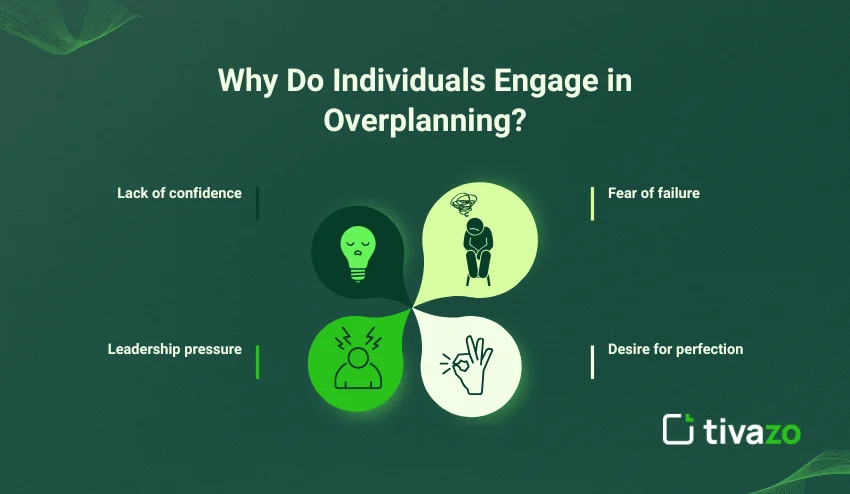
Recognizing the Effect of Overplanning in Contrast to Reality
When Does Planning Become Overplanning?
Planning is considered to be too much when planning delays action. If 70–80% of your discussion is “what ifs,” as opposed to “how to act,” then you are overplanning. This is a common trap that we fall into with both our corporate and individual projects. Understanding the difference between overplanning vs reality helps us conceptualize the difference between meaningful preparation and wasted planning.
When Does Detailed Preparation Begin to Delay Action?
Preparation delays action when:
- You keep reopening the same points during meetings.
- You keep needing to think through the plans instead of acting.
- Deadlines to “finalize” the plan keep being pushed.
When there is a difference between overplanning vs reality, teams tend to confuse meticulousness with effectiveness. The intention is to minimize error, but the aftermath is often delayed projects and dissatisfied team members. It’s important to be able to recognize the tipping point – when the plan is no longer providing value and is causing distractions from meaningful action. Overplanning can cause paralysis by analysis, impede creativity, and ultimately keep teams from adjusting to new experiences promptly. When teams understand the appropriate timing, they can continue to execute on time while ensuring adequate, somewhat thorough preparation.
Applying Overplanning vs Reality in Teams
How Do You Balance Flexibility With Structure Planning?
The sweet spot is “just enough planning” to get alignment on goals, but with enough flexibility to pivot. Achieving this balance is at the core of overplanning vs reality. Relying too heavily on rigid planning means teams might miss opportunities, and only relying on improvised action may lead to teams losing focus.
Tips:
- Employ the 70-20-10 rule: 70% planning, 20% adjustments to the execution, and 10% improvisation.
- Use Agile or Scrum approaches related to iterative action.
- Establish milestones instead of a rigid roadmap to measure progress without sacrificing flexibility.
- What Signs Indicate That Planning Has Become Procrastination?
- The plans are modified more than they are executed.
- The teams are “waiting” for everything to be in the right conditions.
The team spends more time planning software instead of actual work.
If the teams are experiencing these symptoms, then it is a sure indicator that there is an imbalance of overplanning vs reality. The rule of thumb is that leaders should step in and intervene when teams have fallen into inconsistency and get them refocused on researching and planning, and take action. Regular communication checkpoints, setting firmer deadlines for planning, and rewarding execution instead of overplanning can clear some roadblocks and get teams back into a productive state of working.
When teams better understand overplanning vs reality, they can significantly reduce the effects of decision paralysis and create inherently more momentum, while still leaning on valuable planful preparation. Again, the purpose is not to eliminate planning, but it should be there to support execution, not hinder.
Why are users searching for Overplanning vs Reality?
There are not here based on learning theoretical information; users search overplanning vs reality because they want an example, a case study, and something to take away from the search terms. Knowing this, one could potentially work with individuals and a group experiencing this issue to understand when preparation becomes counterproductive to progress. Many professional practitioners look up this topic after experiencing a project that has stalled, a deadline missed, or their team is eagerly waiting for more planning.
Overplanning vs reality leads to an understanding in terms of the potential realities of excessive planning. It often requires hours spent on unnecessary prep time, a firm workflow, and suffering paralysis by oversight. Reality should often take us to a place of adaptability, decision-making, and action with outcomes we can measure. The gap we can describe between overplanning vs reality helps us work towards productivity and real results.
Overplanning vs Reality: Comparative Matrix
| Aspect | Overplanning | Reality |
| Time devoted | Too much focus on details | A limited amount of time, and we have deadlines. |
| Flexibility | The rigidity is hard to adapt to | Constantly changing, this requires a level of agility |
| Team Moral | Frustration & burnout | Can flourish with clarity and quick wins. |
| Speed to execute | Analysis paralysis speed | Formerly quick decision-making |
| Outcome | Often theoretical | Practical, measurable, and real |
By analyzing this comparison, teams can find stability in the overplanning vs reality continuum. The aim will be to normalize and lessen the downside repercussions of overplanning while providing enough structure to drive action to ensure planning leads to tangible outcomes.
When Improvisation Outperforms Detailed Planning
Improvisation often wins in:
- Crises – When time is short.
- Creative industries – When innovation thrives without tight frameworks.
- Startups – When survival hinges on flexibility.
- Unpredictable environments – The market is the market; it doesn’t matter how closely a plan is followed.
In these situations, knowing how overplanning and reality intersect is essential. The pricing graph is as much an idea as it is a plan; it will slow you down and limit creativity, while improvisation enables teams to get moving quickly, respond thoughtfully, and take advantage of unforeseen opportunities. The key is recognizing when to rely on a structure related to planning and when to abandon that to a degree.
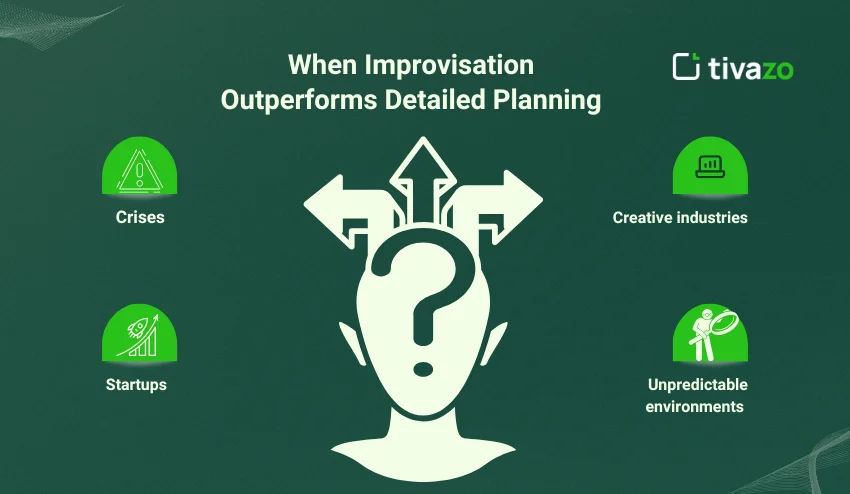
Adapting When Reality Doesn’t Follow the Plan
Reality often derails even the most polished plans. How do we adapt?
- Assess quickly – Don’t cling to failed plans.
- Involve the team – Use their insights to pivot successfully.
- Be outcome-focused – The goal is what’s important, not adhering to the steps.
- Capture what worked/lessons learned – You can reframe the failure as a lesson for the future.
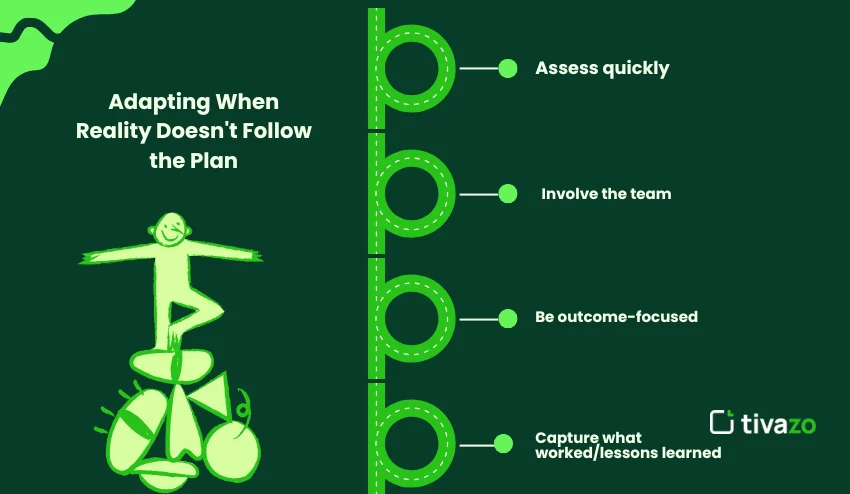
Is “Just Enough Planning” Really the Sweet Spot?
Yes. Research indicates that teams that spend 20–30% less time planning and more time executing and reflecting will be more productive. “Just enough planning” brings the right level of clarity without the over-structure of the plan to counter over-planning vs reality. By considering the most important steps and providing space for flexible change, the organization can act more quickly, eliminate decision paralysis, and confidently react to the unexpected without losing the constraints of an altered timeframe. This provides a balance and enables plans to drive action instead of action driving the plans.
Examples of Overplanning vs. Reality in Practice
- Corporate projects: Multinational companies sometimes are in “strategy mode” for months, and the competition will launch their product much sooner.
- Startups: Many startups fail because they are constantly polishing their business model and never launch their product.
- Personal: Overthinking a career change leads to missed opportunities. Reality always rewards the action.
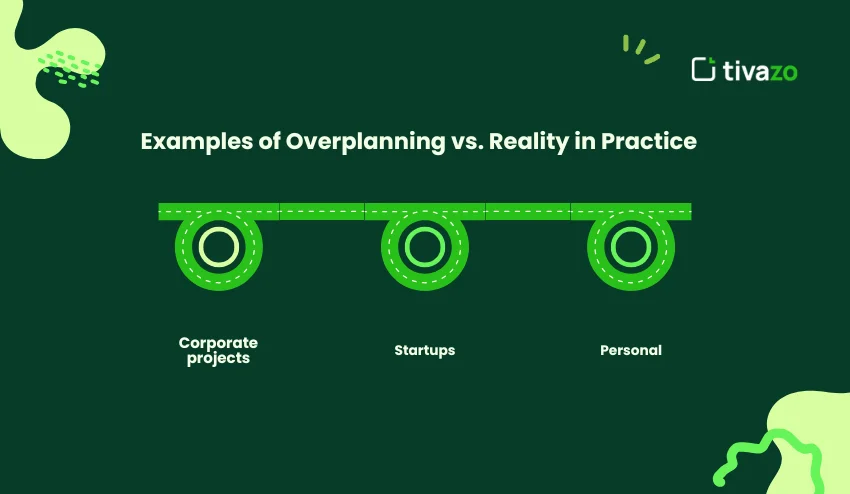
Conclusion
The battle of over-planning vs. real-life everyday execution is one every professional battles. Planning can provide scope and direction; real life requires flexibility, improvisation, and quick execution. It is all about finding the sweet spot of enough planning to keep organized and then being adaptable.
“Just enough planning” is not just a theory; it is the sweet spot to raise productivity, increase morale, and get more done.
